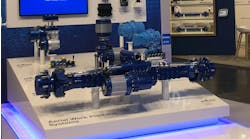Enterprise Software and Automation are Building Blocks to Alleviating Labor Shortages
Software can be a vital tool in many aspects of a business — to aid with engineering efforts, manage manufacturing operations and more. Enterprise resource planning (ERP) is one such software tool which can help with managing day-to-day activities such as supply chain operations.
EPR software can help with the automation of various business aspects and free up workers to focus on other tasks, especially important for today's manufacturers experiencing labor challenges.
For over 50 years, Epicor has developed ERP solutions for those in the automotive, building supply, distribution, manufacturing and retail industries. "But Epicor is not just about the ERP software itself – the additional offerings and modules that add to the system is where businesses can leverage the technology that makes most sense to them. For manufacturing specifically, our knowledge of make-to-order, engineer-to-order, and configure-to-order allows us to offer a strong solution for manufacturing in the 'Make' economy," said Joe Goodrum, General Vice President at Epicor, in an interview with Power & Motion.
During that interview, Goodrum provided insight on the company's ERP solutions and how they can help manufacturers overcome current labor challenges.
*Editor's Note: Questions and responses have been edited for clarity.
Power & Motion (P&M): What aspects of a manufacturing operation can benefit from implementation of software such as that provided by Epicor?
Joe Goodrum (JG): There are many aspects of manufacturing operations that can benefit from implementing enterprise resource planning (ERP) software like Epicor solutions. Most notably, inventory management can be a high time-to-value advantage for a manufacturer. Automation tools that allow you to manage minimum/maximum and safety settings, send automatic recommendations for inventory stocking levels depending on consumption, or optimize inventory and prevent crucial item stock-out situations, lets manufacturers lean on their software solutions to not only stay organized, but potentially transform their manufacturing business into a data-driven organization.
Another area where software can help manufacturers is the lead-to-order cycle. Using add-ons such as Epicor's Internal CRM or Epicor's Automation Studio connectivity tool to connect a best-of-breed system like Salesforce reduces the effort needed to process that opportunity.
READ MORE - From Drafter to Innovator: The Evolution of the Design Engineer
P&M: What role can software play in helping to alleviate the labor shortages facing the manufacturing industry?
JG: Through automation, software can alleviate the time and effort needed for tedious tasks such as data entry and help manufacturing businesses do more with limited labor. The areas to take advantage of this are endless; software such as Epicor ERP can offer automation benefits that allow for continued operational efficiency from the shop floor to the top floor critical to the manufacturing industry.
On the shop floor for example, software automation can help when connecting two machines and automating the information gathering process. This can improve efficiency, so more parts can be made with less resources, less machine time, and ultimately, less labor. On the other hand, automation can significantly assist top floor operations, such as onboarding or other tedious tasks, so staff can focus on growth without having to hire several other people to assist in these efforts.
Additionally, adopting software solutions such as Epicor Kinetic, Epicor’s manufacturing-specific solution, can actually bolster businesses’ competitive edge when it comes to hiring. As skill gaps and labor shortages continue, positioning yourself and your business as a forward-thinking organization with tools in place to make potential hires' jobs easier can be a deciding factor. Today’s high-value candidates are looking for places to work that are rich with technology that is new and intuitive. Enterprise software implementation combined with automation are the technology building blocks manufacturers can put in place to maintain and improve bottom lines while operating with a slimmer workforce.
P&M: What training will be necessary for use of software in manufacturing environments, and how can the industry help to provide it?
JG: With the ongoing skills gap impacting the manufacturing industry, it’s more important than ever that the next generation of manufacturers have some sort of software skills in order to navigate the software systems in place in a new role. We’ve already seen trade schools begin to adopt these practices by offering certifications in various computer programs as part of the curriculum, but with such a variety of enterprise software on the market, these potential hires also need immersive and efficient training once they are on-boarded in a new role. That’s why it's important to choose a technology partner who can provide the level of training content needed for a speedy and actionable onboarding.
With the help of built-in training courses and videos, users can learn how to do new tasks. Over the past few years, Epicor has invested in its Kinetic manufacturing product by making training content available on demand and building it into the product itself. Instead of putting all this information on a training site for training and education purposes, we put it all right where the user can get to it whenever they need it. Users can even turn on field-level help at any time. This lets them move their mouse over any field and get help on how to use it.
Overall, it is up to the technology software vendors to abandon clunky and outdated training manuals and replace them with modern, immersive training content and platforms. This practice can over time narrow the skills gap and enable the next generation of manufacturers to perform at an even higher level.
READ MORE: The Future of Manufacturing and its Impacts on Workforce Development
P&M: As manufacturing facilities become more connected, what benefits can be achieved and what role will software play in this connected environment?
JG: The world in which we know is changing so fast it’s hard to stay in front of it. Everything is becoming more connected, and the manufacturing industry especially is using software and other technology to make connected factories the norm. A connected factory is when you have fully integrated information systems designed to give the right person the right information at the right time, in an easy-to-read report or dashboard. This enables you and your employees to diagnose and resolve supply chain problems in a timely, accurate manner, whether you’re onsite, on the road, or at your home office.
The benefits of a connected factory are endless, but business resilience is the overarching result. With all parties having access to the same critical data, decisions can be made more confidently and lead to overall growth. Software is what filters this data and makes it digestible and actionable.
At Epicor, we have long had connected functionality. Take our Adv MES products for instance; they directly connect Machine Controllers (PLCs) on machining, molding, and fabricating equipment, or high-speed assembly lines. These links have helped customers collect data for quality control, production throughput, and process improvement. In addition, Epicor’s IoT module leverages the power of the Azure IoT hub to connect sensors in products and facilities to better manage assets. This functionality lets customers stay connected to what matters most by tracking assets, triggering system data entry, or forecasting MRO or Field Service activities just to name a few. The benefit of connectivity helps streamline the real-time collaboration between systems, assets, data, and people.
P&M: How do you see the role of software in manufacturing operations continuing to evolve in the coming years?
JG: Automation programs that automate repetitive jobs still have a lot of potential. Employees dislike non-value-added chores. They want to contribute to their company and the future. With software connecting more equipment to process data faster and collecting it more accurately, we’ll likely see continued cloud software adoption and ultimately, more data-driven manufacturing businesses who are prepared to pivot at any given challenge. As we connect more and more systems and devices, we collect massive amounts of data, which is the currency of today and the future.
Data is useless until it becomes information. Business Intelligence tools will help turn data into monetizable information inside and outside the firm. The systems of tomorrow will be more of a real-time collaboration system. These systems will provide the data and information you need without having to go search for it. There will be an abundance of data, but with AI and automation it will be able to predict and execute requests without a thought.



